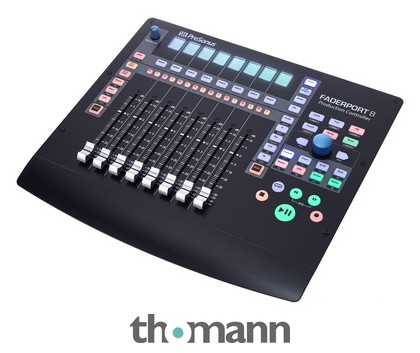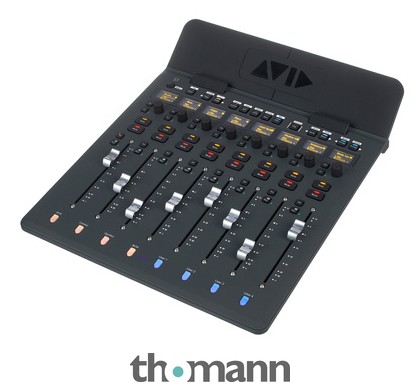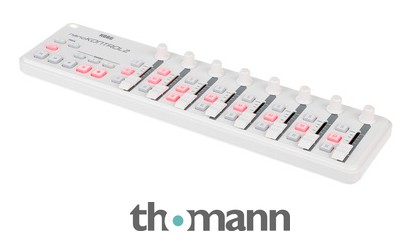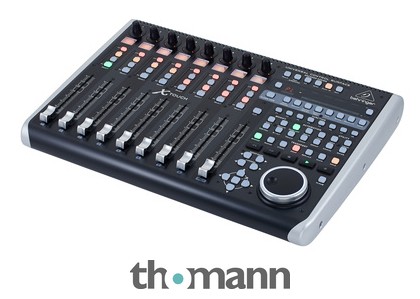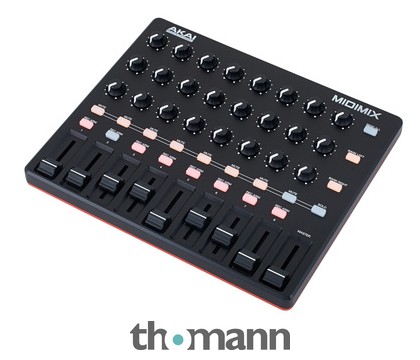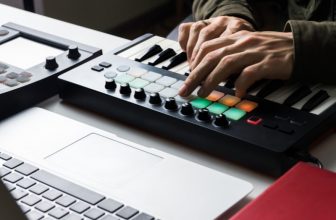The 10 Best MIDI Fader Controllers (2024)
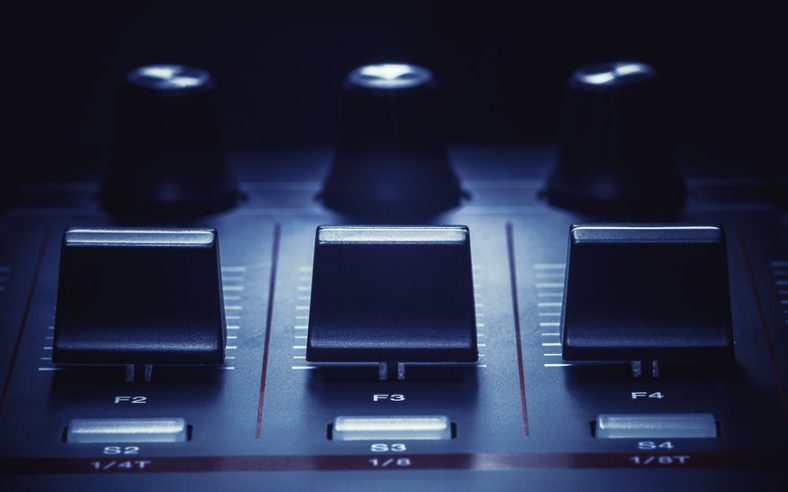
MIDI fader controllers are hardware devices that you can use to efficiently control your DAW’s parameters. Offering faster and more accurate control than a mouse or keyboard, a MIDI fader controller is an obvious addition to any producer’s home studio.
My main recommended MIDI Fader Controller is the PreSonus Faderport 8. With 8 touch-sensitive, motorized faders, this compact device allows for precise tactile control over mix and automation functions, making it a superior solution for anyone who mixes in the box.
For a more budget-friendly option, my second recommended MIDI Fader Controller is the KORG nanoKONTROL 2. This MIDI controller is ultra-compact and has fully-customizable settings. It is compatible with major DAWs and incredibly easy to use.
Music is all about achieving the right mix. As a musician, whether you’re a producer, composer, or DJ, having a MIDI fader controller can take your music creation to new heights. MIDI fader controllers allow you to have precise control over your music and make live mixing a breeze.
Contents
- The Best MIDI Fader Controllers (2024) – At a Glance
- 1. PreSonus Faderport 8
- 2. KORG nanoKONTROL 2
- 3. Avid S1 EUCON
- 4. Mackie MCU Pro
- 5. PreSonus Faderport 16
- 6. Behringer X-TOUCH
- 7. AKAI Professional MIDImix
- 8. Nektar Panorama P1
- 9. Icon QCon Pro G2
- 10. Roland VERSELAB MV-1
- Key Features and Specs to Look for in MIDI Fader Controllers
- Buyers Guide
- Workflow Compatibility
- DAW and Software Integration
- Additional Features and Functions
- I/O (inputs/outputs) and Connectivity
- Making an Informed Decision
- FAQs
- Conclusion
The Best MIDI Fader Controllers (2024) – At a Glance
Let’s see the full list:
1. PreSonus Faderport 8
Controlling your DAW is now simpler with the addition of eight touch-sensitive motorized faders of the PreSonus Faderport 8. I enjoy how these smooth faders offer accurate control for mixing and improve the recording process. Using these faders along with the user-friendly design allows for comfortable and precise control during mixing sessions.
Pros
- Easy integration with popular DAWs
- Session Navigator simplifies navigation and editing tasks
- Compact, ergonomic design for comfortable use
- Plug-and-play functionality
- Durable build quality
Cons
- Limited functionality with older operating systems
- Scribble strips difficult to read from certain angles
- A bit pricey
A unique feature of the PreSonus Faderport 8 compared to older versions is the inclusion of eight high-resolution scribble strip screens. These screens give a clearer visual display of your tracks and settings, improving both user experience and efficiency in the studio. No more guessing – just better accuracy in your mixing.
This controller offers great compatibility, working smoothly with well-known Mac OS X and Windows DAWs, as well as supporting HUI and Mackie Control protocols. Whether you use Ableton Live or PreSonus Studio One, the customizable buttons and workflow options make this a flexible tool that adjusts to your needs, providing a truly enjoyable creative experience.
Specs
- Faders: 8 Touch-sensitive motorized faders
- Compatibility: Universal – Mac OS X, Windows
- Connectivity: USB 2.0
- Voltage: 12 Volts
2. KORG nanoKONTROL 2
This multi-functional control interface is compact and versatile, making it great for mobile music creation and live shows. Being lightweight, you can take your creativity anywhere. The USB connection provides power and data transfer in one, making for a tidier workspace.
Pros
- Low-profile, multi-function control surface
- Supports numerous software titles including major DAW programs
- USB-powered for portability and convenience
- Easy to set up and use
- Can be used with Korg KONTROL editor software for customization
Cons
- Short and stiff faders might be difficult to control
- All-plastic build
- Buttons and slider caps may fall off easily
With eight controller channels, the nanoKONTROL 2 allows for easy control of many audio software features like pan, volume, and solo/mute/record through dedicated knobs, faders, and switches. Using the marker function, marking important points in your track is simple, leading to a smooth recording and production process.
You can also customize your experience with the KORG KONTROL Editor software, giving you lots of personalization options for control change messages and other settings. Compatibility with major DAW programs makes it easy to use different applications, which is why I like this electronic music-focused design.
Specs
- Channels: 8
- Connectivity: USB
- Faders: 8 Touch-sensitive
- Compatibility: Most major DAWs
3. Avid S1 EUCON
Firstly, the compatibility of the Avid S1 EUCON is amazing, as it works well with Windows devices and supports different control protocols. The control surface offers better integration and faster software usage, which makes your creative process smoother. I appreciate that it’s a powerful module with advanced features in a compact size.
Pros
- Powerful and versatile module
- Works well with iPad and ProTools
- A small version of large studio systems
- Features like folder tracks, VCA spill, and high-resolution metering
- Compatible with Windows
Cons
- Tablet not included
- Pricey
Also, the touch-sensitive motorized faders make a big difference. With eight long-throw faders, this control surface provides a better mixing experience, letting you control your audio sessions more accurately. It also has eight touch-sensitive, adjustable encoders, so you can tweak settings to your liking for full control over your work.
Another great feature is the high-resolution OLED displays. With eight clear OLED panels, you can see real-time visuals that help you evaluate and adjust your mix faster. The built-in stand for tablets and USB charging port also make it easy to use tablets for more control and display options. Overall, it lets you work more effectively in your studio.
Specs
- Faders: 8 Touch-sensitive motorized faders
- Compatible Devices: Mac OS/Windows
- Connectivity: Connect up to Four S1 Controllers, Avid Dock, Avid Control
- Software: Avid Control App
4. Mackie MCU Pro
The Mackie MCU Pro is a pro-grade choice. Enjoy smooth music production using the unique Mackie communication protocol in this advanced instrument. I like its user-friendly and professional design and construction, making it easy to blend with your favorite software.
Pros
- Seamless music production software integration
- 100mm touch-sensitive motorized faders
- V-Pot control over software, plug-in effects, and virtual instruments
- More than 50 dedicated push-buttons
- Highly compatible with most major music production software
Cons
- Issues with faders out of calibration
- Occasional display blackouts
- Pricey
It features 100mm touch-sensitive motorized faders. These high-quality faders provide unparalleled accuracy, helping you reach the perfect sound mix. The sheer customization possibilities are endless with 50 dedicated buttons to play around with.
Improve your production with many customization choices and infinite bank support for channel management. Built-in Lexan overlays make it simple to modify this versatile controller to meet your needs, and the large, seven-segment LED timecode display ensures precise mixing. Not to mention, it is universally compatible with major DAWs.
Specs
- Connectivity: USB
- Faders: 9 Touch-sensitive motorized faders
- Encoders: 8 Rotary encoders
- Compatibility: Mac/PC
5. PreSonus Faderport 16
Dive into the world of accurate mixing with this advanced USB controller, featuring 16 motorized, touch-sensitive faders. The high-resolution faders offer smooth control and increased accuracy when adjusting levels. Explore new musical possibilities with alternate fader modes for plug-ins, bus sends, and panning.
Pros
- 16 touch-sensitive motorized faders
- 89 buttons covering 104 functions
- Compact size easily fits on a desk
- High-definition scribble strip displays
- Session Navigator for quick control
- Compatible with major DAWs
Cons
- Monochromatic LCD scribble strips may lack contrast
- Some functions may not work with all DAWs
- A bit pricey
Small but packed with features, the PreSonus Faderport 16 is perfect for any musician’s studio. With 89 buttons and 104 different functions, fine-tuning is hugely available. The clear Scribble Strip displays make channel identification easy, letting you focus on creating music.
One thing I appreciate about this USB controller is its smooth integration with Studio One and precise controls. It works seamlessly with popular recording software like Studio One Artist and is compatible with programs like Logic Pro X, Cubase, Ableton Live, and Pro Tools through Mackie Control Universal and Mackie HUI emulation. Plus, it comes with Ableton Live Lite and the Studio Magic plug-in suite.
Specs
- Faders: 16 Touch-sensitive motorized faders
- Controls/Buttons: 89 buttons covering 104 functions
- Displays: 16 high-definition Scribble Strip displays
- Software: Studio One Artist, Ableton Live Lite, and Studio Magic plug-in suite
6. Behringer X-TOUCH
The Behringer X-TOUCH Control Surface has many features that make music production easier and more enjoyable. It works with HUI and Mackie Control protocols, so it’s great for live shows and studio work. The nine motorized faders are touch-sensitive and automated, making mixing smoother.
Pros
- Smooth faders and simple to control
- Heavy and does not feel cheap
- Colorful lights and easy visual feedback
- Supports HUI and Mackie Control protocols
- 9 motorized faders and 8 LCD Scribble Strips
- Universal DAW compatibility
Cons
- Documentation may be weak and relies on YouTube tutorials
- Bulky design
I really like the smooth faders and colorful lights on this control surface. One exceptional feature is the eight LCD Scribble Strips, which show track names and settings quickly. There are also 92 backlit buttons for easy access to important functions. The control surface has an 8-segment LED meter for each channel, so you can keep track of levels during recording.
Another notable feature is the Ethernet connectivity, which allows for real-time MIDI and possible future compatibility with the Behringer X32 remote control. The controller has several USB and MIDI connections, as well as wireless network compatibility. This makes it easy to connect to various devices and setups.
Specs
- Faders: 9 fully automated and touch-sensitive 100 mm faders
- Connectivity: Ethernet/USB/MIDI Interface
- Controls: 92 dedicated buttons and 8 rotary encoders with LED collars
- LED Meters: 8-segment per channel
7. AKAI Professional MIDImix
This user-friendly MIDI mixer simplifies connecting your mixer to your DAW, mastering full mixing integration with just one button press. It easily works with different DAWs and live performance apps, such as Logic, Studio One, Cubase, and ProTools. Enjoy smooth, hands-on mixing with control over any MIDI feature, letting your creativity flow without interruption.
Pros
- Quick and easy controller for live DJ sets
- Works well with various DAWs
- Compact, lightweight, and portable design
- 8 individual line faders and 1 master fader for mix control
- Customizable MIDI controls with 24 knobs and 16 buttons
Cons
- Poor knob design
- Works best with Ableton Live, may require extra effort for other DAWs
- Plastic build quality
The akai professional MIDImix offers portability and control, featuring 8 channel faders, 1 master fader, 24 mappable control dials, and 16 mute, solo, and record arm buttons. It helps you manage track levels, virtual instrument parameters, and effects easily.
Specs
- Connectivity: USB
- Faders: 8 Line Faders
- Knobs: 24 Knobs
- Controls/Buttons: 16
The MIDI mixer stands out with direct mapping capabilities and a unique software editor. It instantly connects with Ableton Live Lite and allows easy preset customization and setting management on Mac and PC. Additionally, it has a range of instruments, effects, and presets for your music projects.
8. Nektar Panorama P1
The Nektar Panorama P1 MIDI controller offers excellent compatibility with digital audio workstations (DAWs) like Cubase, Logic, and Studio One. It has great integration and control for Reason, allowing your creativity to grow easily with your favorite software. Working with both Mac and PC, the P1 is an all-in-one solution for smooth production and communication.
Pros
- Deep DAW integration for various software
- Comprehensive MIDI functionality
- Good build quality
- Useful for live and studio situations
- Compatible with both Mac and PC
Cons
- Complex setup and installation
- Not user-friendly for beginners
- Non-motorized faders
With its versatile MIDI features, the P1 MIDI controller is perfect for all your music production needs. This lightweight device easily connects to all MIDI-based music software and can easily travel with you. It’s an ideal creative partner.
The small design of the P1 MIDI controller fits well in tight spaces without losing any features. This controller provides many sound possibilities in a compact size. You can enhance your experience with the included PreSonus Studio One Artist DAW software for endless creativity.
Specs
- Faders: 9 Standard
- Connectivity: USB
- Display: Color TFT
- Compatibility: Mac and PC
9. Icon QCon Pro G2
Imagine being fully engaged in your favorite DAW, easily adjusting levels using nine touch-sensitive motorized faders. The QCon Pro G2 offers this and more. You get to enjoy precise hands-on control of your mix. I really appreciate its simple setup and smooth integration with various DAWs, making the QCon Pro G2 a useful addition to any musician’s setup.
Pros
- Universal DAW control surface
- Presets and overlays for multiple DAWs
- Large backlit LCD for channel info display
- Illuminated buttons for easy controls
- Includes free recording software
Cons
- Transport controls placement is not ideal
- LED visibility issue at certain angles
- A bit pricey
Visualize quickly navigating your DAW with eight push encoders and 78 backlit buttons, each dedicated to specific tasks like record-enable, solo, mute, and more. The QCon Pro G2’s wide range of controls provides an unmatched user experience, making sessions well-organized and efficient.
Combined with a high-speed USB 2.0 interface, you can simply plug in and start working on your creative projects without limitations. Customizable presets and overlays also ensure you have accurate, guided control over any task. All in all, it’s a well-rounded and solid all-in-one solution.
Specs
- Connectivity: USB
- Faders: 9 Touch-sensitive motorized faders
- Display: Large Backlit LCD
- Channel Buttons: Rec-enable, solo, mute, select, and monitor
10. Roland VERSELAB MV-1
Dive into a world of captivating sounds with over 3000 samples from the renowned Roland sound archive. You get to explore the endless opportunities offered by the ZEN-Core Synthesis System, known for its impressive audio quality and versatility.
Pros
- User-friendly for music production
- High-quality vocal recording effects
- Over 3000 built-in curated Roland sounds
- Versatile with plug-and-play Zenbeats integration
- Compact and portable for collaborations
Cons
- Complex for beginners
- Tiny screen
- A bit pricey
What I appreciate about the MV-1 is its user-friendly design and all-in-one studio features, offering an unmatched creative experience. Its intuitive music-making process, colorful pads, and controllers feel like an extension of your hands, making it easy to create your unique sound. The well-known TR-REC step sequencer adds to this hands-on experience, allowing you to build rhythm, basslines, and melodies effortlessly.
Roland’s MV-1 provides a strong, integrated vocal effects suite for improving vocal tracks. Auto-Pitch, Harmonizer, and Doubler effects blend well to produce a refined sound that catches attention. The device grants the power to unleash your vocal capabilities and widen your artistic possibilities.
Specs
- Sounds: Over 3000 Roland sounds
- Built-in vocal effects: Auto-Pitch, Harmonizer, Doubler
- Pads: 4×4 pads
- Screen: LCD Display
Key Features and Specs to Look for in MIDI Fader Controllers
Among many useful features, there are features and specs like build quality, portability, hardware, included software, and more that you need in a MIDI Fader controller. Weighing the options and carefully considering them is how you should choose the right one for you.
Number of Faders and Controls
When considering the number of faders and controls on a MIDI fader controller, it’s essential to think about your specific needs and requirements during music production. MIDI controllers, such as PreSonus FaderPort 16 and AKAI Professional MIDImix, offer multiple faders, knobs, and buttons, which can be useful for complex projects or for controlling various parameters at once.
On the other hand, some might find a more compact option like the Korg nanoKONTROL 2 more suitable for their needs, as it still provides eight channels with a dedicated knob, fader, and three switches for each channel. It’s important to weigh the pros and cons of additional faders and controls before making your decision.
Build Quality and Reliability
In choosing a MIDI Fader Controller, it is essential to consider the build quality and reliability of the product. High-quality materials and solid construction ensure that the controller can withstand daily use as well as transport. Sturdy faders, smooth potentiometers, and responsive buttons play a vital role in delivering precise control and accurate automation.
For example, the PreSonus FaderPort 16 offers 16 touch-sensitive, motorized faders, while the Mackie Control Universal Pro features 9 100mm touch-sensitive faders. In both cases, the build quality of faders and other components contributes significantly to the overall user experience, ensuring durability and reliability in even the most demanding studio environments.
Hardware and Software Compatibility
When considering a MIDI fader controller, it’s important to ensure that the hardware and software are compatible with your existing setup. Controllers like the PreSonus FaderPort 16, for example, integrate seamlessly with multiple DAWs, like Ableton Live, Logic Pro X, Cubase, and Pro Tools, due to its support for Mackie Control and HUI protocols.
Similarly, the Korg nanoKONTROL 2 is designed to work with various software titles, including major DAW programs. By making certain that your chosen controller can communicate effectively with your preferred DAW or other music software, you’ll be able to maximize your workflow efficiency and make the most out of your MIDI fader controller investment.
Portability and Size
When considering a MIDI fader controller, portability and size are crucial aspects for musicians and music writers on the go or those with limited studio space. Compact and lightweight devices provide convenience when working on different projects or collaborating with other artists.
For instance, the AKAI Professional MIDImix offers an impressive range of features in a portable package, while the PreSonus FaderPort 8 blends ergonomics with a space-saving design making it an ideal choice. While larger controllers like the Mackie Control Universal Pro deliver extensive capabilities, it’s essential to weigh the benefits of their features against the potential inconvenience of their size.
Budget and Price
When considering the purchase of a MIDI fader controller, budget and price plays a significant role in the decision-making process. I can understand the desire to find a quality controller that doesn’t break the bank but still meets your specific needs. The good news is that there’s a wide range of options available, so you’re bound to find one that suits your budget.
For instance, the Korg nanoKONTROL 2 is a low-profile, multi-functional control surface that’s affordable and ideal for musicians needing essential controls without too many bells and whistles. On the other hand, if you have a higher budget and require more comprehensive features, options like the PreSonus FaderPort 16 or the Mackie Control Universal Pro are worth considering.
Buyers Guide
Workflow Compatibility
Your MIDI fader controller should fit seamlessly with your workflow to ensure a smooth music production experience. Consider the layout and design of the fader controller and how it will complement your existing setup. Controllers like the Presonus Faderport8 are designed for streamlined workflows and rapid access to important functions, making them ideal for users who prefer efficiency.
DAW and Software Integration
Integration with your preferred Digital Audio Workstation (DAW) and other software plays a significant role in determining the perfect MIDI fader controller. Controllers like the Behringer X-TOUCH and Avid S1 offer seamless integration with popular DAWs, thanks to their compatibility with various protocols such as HUI and Mackie Control.
Additional Features and Functions
MIDI fader controllers often come with additional features like knobs, buttons, and pads to enhance their functionality. Examining your music production requirements will help you determine which additional features are most valuable to you. Products like the Nektar Panorama P1 and Roland VERSELAB MV-1 come equipped with various controls and features to ensure a versatile production experience.
I/O (inputs/outputs) and Connectivity
Various connection options like MIDI, USB, and even iOS compatibility can enhance a MIDI fader controller’s functionality and versatility. Consider your connectivity needs and ensure the controller you choose offers appropriate inputs, outputs, and compatibility. Devices like the QCon Pro G2 offer comprehensive I/O options to meet a range of connectivity needs.
Making an Informed Decision
Researching and comparing different options on the market is essential for an informed decision. Read user reviews, explore product specifications, and consider the factors mentioned in this guide to make the most knowledgeable choice.
FAQs
1. What are MIDI Fader Controllers?
A MIDI fader controller is a hardware device that allows musicians and music producers to control various parameters of their music production software or hardware equipment in a real-time, hands-on manner. It consists of multiple sliding faders compatible with MIDI protocols that can be assigned to control different functions of the music software.
2. What are the benefits of using a MIDI fader controller?
MIDI Fader Controllers offer precise and tactile control over sound levels, allowing for a more hands-on approach to music production and live performances.
3. Can I use a MIDI fader controller with any software/hardware?
Most MIDI fader controllers are designed to work with a wide range of music software and hardware that supports MIDI messages. It’s important to check compatibility before purchasing.
4. How many faders do I need on a MIDI fader controller?
The number of faders needed depends on the user’s setup and preferences. For basic mixing, 8 or 16 faders are sufficient. However, for advanced production or live performances, more faders may be necessary.
Conclusion
In conclusion, whether you’re a producer, engineer, or just a music enthusiast, a good MIDI fader controller is a crucial tool to have in your studio setup. So do your research, weigh your options, and find the one that fits your needs and budget.
My main recommended MIDI Fader Controller is the PreSonus Faderport 8. It comes with 8 touch-sensitive, motorized faders, and is a very compact device that allows for precise tactile control over mix and automation functions.
My second recommended MIDI Fader Controller is the KORG nanoKONTROL 2. This MIDI controller is a budget-friendly, ultra-compact, and fully-customizable option. It is compatible with major DAWs and incredibly easy to use.

